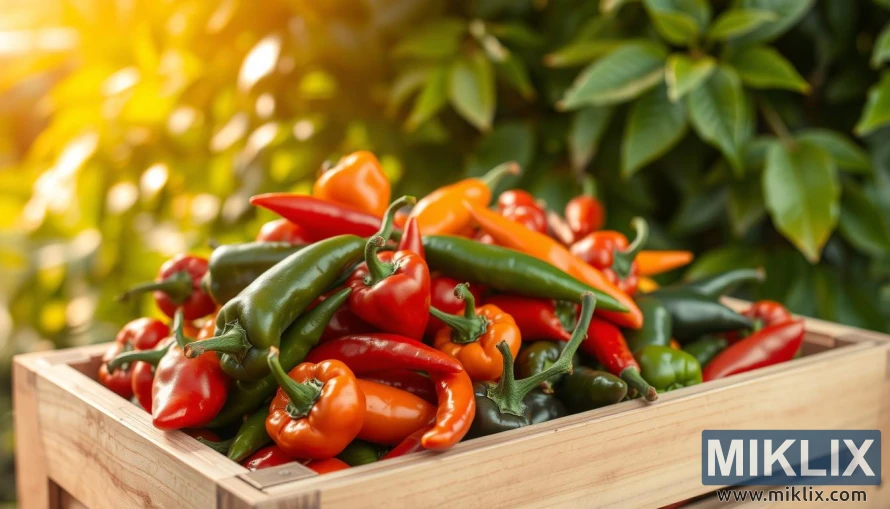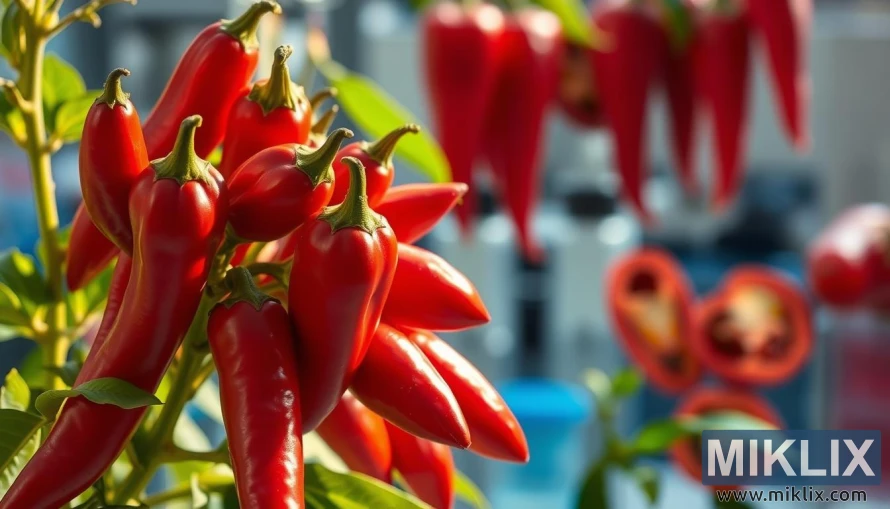Spice Up Your Life: How Chili Boosts Your Body and Brain
Published: March 26, 2025 at 6:30:32 PM UTC
Last updated: March 28, 2025 at 3:16:06 PM UTC
Chili peppers are more than just a spice; they're a nutritional powerhouse. Originally from South and Central America, they now spice up dishes around the world. Their heat comes from capsaicin, which has health benefits like fighting inflammation and boosting metabolism. From Mexico to Asia, chili adds bold flavor. It also packs nutritional benefits like vitamin C.
Key Takeaways
- Chili peppers deliver vitamin C surpassing oranges, aiding immune function.
- Capsaicin in spicy food may reduce inflammation and support heart health.
- Low-calorie content (6–14 calories per serving) makes them a nutrient-rich choice.
- Antioxidants like capsanthin in red chilies may fight cell damage.
- Moderate chili intake aligns with health advantages, but requires caution for those with sensitive digestive systems.
What Makes Chili Peppers Special
Chili peppers are unique in the plant world because of their bioactive compounds. At the core of their heat is capsaicin, the spicy ingredient that gives them their burn. This compound does more than just heat up your mouth—it can also boost your metabolism and help with pain.
What really sets chili peppers apart is their variety. You can find everything from mild bell peppers to the extremely hot Pepper X (2.69 million Scoville Heat Units). Popular peppers like jalapeños, habaneros, and cayenne add different flavors and heat levels. They come in colors like red, orange, green, and purple, showing their unique tastes and nutritional values.
- Bell peppers: 0 SHU, sweet and crisp
- Jalapeño: 3,500–10,000 SHU, earthy with a quick kick
- Habanero: 100,000–350,000 SHU, tropical fruit notes
The science behind their heat is fascinating. Capsaicin interacts with pain receptors (TRPV1), causing a burning feeling without harming tissues. This is why water doesn't cool down the heat—it's because capsaicin is oil-based. Chilies also contain antioxidants like vitamin C (160% DV per 100g) and flavonoids, which help the immune system and heart health.
Humans have grown chilies for over 9,500 years, with Peru having the most species. Even Columbus called them "peppers" because they reminded him of black pepper. Today, they're grown all over the world, with China leading in production. Chilies are used in many dishes and are also studied for their ability to target cancer cells, making them a true marvel in both cooking and science.
Nutritional Profile of Chili
Chili peppers are packed with nutrients in every bite. A half-cup of canned green chili peppers has only 14 calories. But they give you 72% of your daily vitamin C. This vitamin boosts your immunity and skin health.
- Vitamin C: 64.7 mg per serving—more than citrus fruits per gram.
- Vitamin A: 21.6 mcg from beta-carotene for eye and immune health.
- B Vitamins: B6 aids metabolism, and folate supports cell function.
- Minerals: Copper for nerves and iron for blood health.
These fiery pods also offer dietary fiber (0.7g per serving) for better digestion. Their antioxidants, like capsaicin, fight cell damage. Even a small portion—like 45g of chili—gives you 6% of daily vitamin K for strong bones and 5% of manganese for antioxidants.
Chili's nutrients change with ripeness: mature peppers have more vitamin C and flavonoids. Their low-calorie profile makes them a great choice for healthy eating. Chilies are a small but mighty source of essential nutrients.
Metabolism Boosting Properties
Chili peppers have capsaicin, which starts thermogenesis. This is when your body burns calories to make heat. It boosts your metabolic rate, helping you burn more calories. Studies show eating just 10 grams of red chili pepper can increase fat burning by up to 8%.
Thermogenesis also turns brown fat into energy instead of storing it. A 2014 study found eating 6–10 mg of capsaicin (like in one jalapeño) can cut calorie intake by 70–100 per meal. This leads to noticeable weight loss without needing extreme diets.
- Increased metabolic rate: Capsaicin raises energy expenditure by up to 5%, helping burn an extra 50–100 calories daily.
- Appetite control: Studies show red pepper consumption reduces later meal intake by 10–15%, curbing overeating.
- BAT activation: Capsaicin stimulates brown fat activity, making fat burning better even when you're resting.
Eating chili with protein-rich meals boosts its effects. Protein alone can increase metabolic rate by 15–30%. To get the most benefits, add chili to breakfast or before working out. But, effects may lessen over time—using chili every other day keeps its calorie-burning power.
These small changes can help with long-term weight management. Adding chili to your diet can make a big difference without needing big changes.
Anti-Inflammatory Effects of Chili Peppers
Chronic inflammation is linked to diseases like arthritis and heart disease. Chili peppers, rich in capsaicin, help fight this. Capsaicin blocks inflammatory pathways and reduces harmful molecules like IL-1β.
Studies show that moderate amounts of capsaicin are safe and effective. But, too much can cause stomach problems in animal tests. This shows we need to eat chili peppers in the right amount.
Capsaicin works by reducing harmful signals in the body. It also has antioxidants like sinapic and ferulic acid that help. The FDA has approved capsaicin for topical use to treat pain.
Eating chili peppers can also help fight inflammation all over the body. It can lower markers like CRP when used right.
Adding chili to meals with foods like turmeric or broccoli can make it even better. But, eating too much can upset your stomach. Always talk to a doctor before taking supplements, and start with small amounts.
Chili for Heart Health
Adding chili to your diet can help your cardiovascular benefits and fight heart disease prevention. Studies show people who eat chili peppers have a 26% lower risk of heart-related deaths. Capsaicin in chili improves blood pressure and cholesterol levels.
Capsaicin lowers bad cholesterol and raises good cholesterol. This helps keep arteries healthy.
Chili also helps with circulation by making blood vessels work better. Capsaicin's anti-inflammatory effects reduce artery inflammation. This slows down plaque buildup that causes atherosclerosis.
Research also links chili to better blood sugar control. This lowers diabetes risks, a big heart disease cause.
A heart-healthy chili recipe uses lean turkey and beans. Beans are high in fiber, which lowers cholesterol. Black olives reduce sodium intake.
Spices like cumin and cayenne add flavor without salt. This helps manage blood pressure. Even a little chili can help reduce clotting and improve artery flexibility.
Choose recipes with lean beef or plant-based proteins to keep saturated fats low. Pair chili with Greek yogurt for protein or lime for antioxidants. Both are good for vascular health.
Pain Relief Properties
Capsaicin, found in chili peppers, is a surprising natural pain reliever. It works by interacting with TRPV1 receptors, which are nerve pathways that send pain signals. Over time, this interaction makes these receptors less sensitive, helping to reduce pain from conditions like neuropathic pain.
The FDA has approved capsaicin cream and topical treatments for managing diabetic nerve pain and post-shingles pain. These products block pain signals but don't numb the skin. They provide long-lasting pain management.
- Effective for neuropathic pain, arthritis, and musculoskeletal aches.
- Studied for conditions like burning mouth syndrome and chemotherapy-induced mouth sores.
- Available as patches, creams, or gels for targeted relief.
Research shows that using capsaicin cream daily can help reduce pain over time. A 2020 study found that eating 30 grams of chili powder daily was safe for most adults. While some people may experience skin irritation, severe reactions are rare.
Capsaicin combines traditional chili uses with modern science, making it a bridge between ancient remedies and today's pain solutions. Always talk to a doctor before trying high-dose treatments, and start with small doses in meals for mild benefits without harsh side effects.
Immune System Support from Chili Consumption
Chili peppers are a top vitamin C source, with more of this nutrient than oranges. Vitamin C boosts immune function by helping white blood cells fight off colds and infections. Chilies also have antioxidant properties from capsaicin, quercetin, and beta-carotene, protecting immune cells from damage.
Capsaicin, the heat in chilies, fights infections. Studies show it can stop harmful bacteria and fungi. Eating chilies regularly can lower your risk of death by 12%, according to a study of 500,000 people over seven years. Chilies also help your gut health, which is key for a strong immune system.
- Snack on fresh chili slices dipped in guacamole for a immune boosting foods combo.
- Add crushed red pepper to soups or stews to boost antioxidant intake.
- Try chili-infused teas to support respiratory health during cold seasons.
While chilies are good for the immune system, eat them in moderation. Too much can upset your stomach, but there's no serious risk of overdose. Mix chilies with vitamin C-rich foods like citrus or leafy greens for the best immune support. Adding small amounts of chili to your meals can keep your immune system strong.
Digestive Health and Chili
Spicy food effects on the digestive system vary widely between individuals. Chili's capsaicin may boost digestive enzymes and aid gut health. But, it can also worsen symptoms for those with digestive disorders. For example, people with irritable bowel syndrome (IBS) might experience diarrhea or pain.
Yet, long-term consumption could reduce abdominal discomfort over time.
A 6-week study with 16 IBS patients showed daily chili intake (2.1g) reduced abdominal burning scores compared to placebo. Initial use caused temporary discomfort, but after 5 weeks, participants reported less pain. Capsaicin also inhibits H. pylori, a bacteria linked to stomach ulcers, which offers stomach benefits.
Researchers found capsaicin boosts gut microbiome diversity, increasing beneficial bacteria like Akkermansia while reducing harmful strains. This shift may improve gut health by increasing nutrient absorption and reducing inflammation. But, those with acid reflux or ulcers should start slowly.
Begin with small amounts, eat with meals, and remove seeds to minimize irritation.
Data shows mild side effects like temporary burning occurred in 4 participants, but no serious issues. For optimal results, pair chilies with fiber-rich foods to ease digestion. While spicy foods aren't universally harmful, personalized tolerance matters.
Balancing intake aligns with gut health goals, making chilies a double-edged tool for the digestive system.
Potential Cancer-Fighting Properties
Chili peppers have caught the attention of cancer research due to their anticancer compounds, like capsaicin. Studies show capsaicin can kill over 40 types of cancer cells. It also stops cancer from spreading in prostate cancer models and reduces liver lesions in rats.
But, human studies show a different story. Eating a lot of chili peppers might increase the risk of stomach and gallbladder cancers. In Mexico, where people eat a lot of chili peppers, stomach cancer is a big problem. But, how chili peppers are cooked matters a lot.
A 2023 study looked at 16 studies and found that eating chili peppers increased the risk of stomach cancer by 51%. Scientists say it's all about how much you eat. Eating too much chili pepper can be bad, but a little bit might be okay.
Experts say it's important to find a balance. Eating chili peppers in moderation is key. Adding antioxidants like resveratrol to capsaicin can make it even more effective against cancer. But, it's important to avoid charring chili peppers and not eat too much.
Longevity and Chili Consumption
Studies show that chili peppers might help us live longer. A big study looked at over 570,000 people in four countries. It found that those who ate chili often had a 25% lower risk of dying early.
People who ate chili four or more times a week had a 34% lower risk of heart disease deaths. They also had a 23% lower risk of dying from cancer.
- 25% lower all-cause mortality risk among regular chili eaters
- 34% reduced cardiovascular death risk in long-term studies
- 23% lower cancer mortality linked to frequent consumption
In places known as "blue zones," like parts of China and the Mediterranean, chili is a staple. Scientists think it's because of capsaicin, a compound in chili. This compound makes our cells work harder, which might help slow down aging.
Eating chili as part of a healthy diet could help prevent aging. It's best to mix it with veggies, healthy fats, and whole grains. Even a little chili, like a sprinkle on your food, could help keep you healthy for years.
But remember, eating chili every day for years is key. Always talk to a doctor before making big changes to your diet.
Possible Side Effects and Precautions
Chili peppers are good for health, but they can upset some stomachs. People with acid reflux or sensitive stomachs might get heartburn, nausea, or stomach pain. Those with irritable bowel syndrome (IBS) could experience diarrhea or cramps.
About 2% of people have chili allergies, leading to skin rashes, itching, or swelling. In severe cases, it can cause anaphylaxis, like in a 2023 spicy food challenge. If you're sensitive, stay away from super spicy peppers like ghost peppers. They have capsaicin, which can irritate your stomach lining, worse for those with ulcers or dyspepsia.
- Limit intake to ½ cup per meal to reduce risks.
- Wear gloves when handling hot peppers to avoid skin irritation.
- Choose mild peppers if you’re new to spicy foods.
- Drink milk or eat rice to neutralize capsaicin’s heat.
Too much chili can lead to vomiting or diarrhea, seen in the 2023 "One Chip Challenge" incidents. If you have chest pain or trouble breathing, get medical help right away. Always talk to a doctor if you have GI issues or allergies. Being careful and aware helps enjoy chili's benefits without risks.
Delicious Ways to Add More Chili to Your Diet
Exploring chili recipes doesn't mean you have to love extreme heat. Begin by adding chili flakes to scrambled eggs or tossing sliced peppers into salads. Even mild peppers like poblano or Anaheim are great for those new to chili.
Mixing chili powder uses into soups or marinades adds depth without being too spicy.
- Stir chili powder into pasta sauce or sprinkle over roasted veggies.
- Blend fresh peppers into salsas or guacamole for a zesty twist.
- Use chili recipes like Thai curries or Indian chutneys to explore global flavors.
- Add diced peppers to tacos or fajitas for a quick spicy dishes upgrade.
To balance heat, remove pepper seeds or pair with yogurt-based sauces. For deeper flavor, try simmering chili dishes longer or adding tomato paste. Experiment with cooking with peppers in soups, stews, or as garnishes. You can also freeze, dry, or make spicy infusions like chili oil with excess peppers.
Whether sprinkling flakes on pizza or mixing into bean-based dishes, there's a meal idea for every palate. Start with mild options and gradually explore hotter varieties. Your taste buds will thank you!
Conclusion
Chili peppers are more than just spicy additions to meals. They are full of nutrients that are good for your health. They have vitamins C and A, which are antioxidants. These help boost your metabolism and support your heart health.
Studies show eating chili peppers regularly can lower heart attack risk by 26%. They also help improve your cholesterol levels. These colorful veggies also aid in digestion and may help manage pain.
Adding chilies to your diet can bring lasting health benefits. With 59% of young U.S. adults already enjoying spicy foods, it's a trend that's here to stay. Start with jalapeños or bell peppers and then try hotter ones like habaneros.
Capsaicin in chilies boosts metabolism and they are full of vitamins. Pair them with whole grains, lean proteins, and other veggies for a balanced meal. This way, you get the most out of your diet.
Cooking with chilies combines flavor with health benefits. Their vitamins, potassium, and antioxidants make any dish healthier. Whether you add paprika to eggs or fresh chili to soups, small changes can make a big difference.
Choose your preferred heat level and enjoy the journey. Your taste buds and body will thank you. Over 40% of Americans already enjoy spicy foods. Let chilies be your gateway to a tastier, healthier plate.
Nutrition Disclaimer
This page contains information about the nutritional properties of one or more food items or supplements. Such properties may vary worldwide depending on harvest season, soil conditions, animal welfare conditions, other local conditions, etc. Always make sure to check your local sources for specific and up-to-date information relevant to your area. Many countries have official dietary guidelines that should take precedence over anything you read here. You should never disregard professional advice because of something you read on this website.
Furthermore, the information presented on this page is for informational purposes only. While the author has put reasonable effort into verifying the validity of the information and researching the topics covered here, he or she is possibly not a trained professional with a formal education on the subject matter. Always consult with your physician or a professional dietician before making significant changes to your diet or if you have any related concerns.
Medical Disclaimer
All content on this website is for informational purposes only and is not intended to be a substitute for professional advice, medical diagnosis, or treatment. None of the information here should be considered medical advice. You are responsible for your own medical care, treatment, and decisions. Always seek the advice of your physician or another qualified healthcare provider with any questions you may have regarding a medical condition or concerns about one. Never disregard professional medical advice or delay seeking it because of something you have read on this website.




